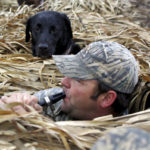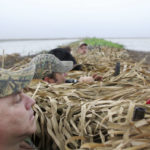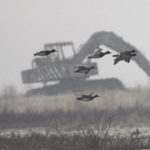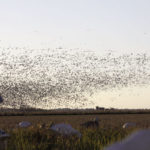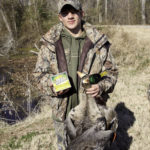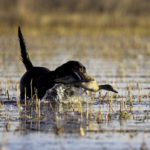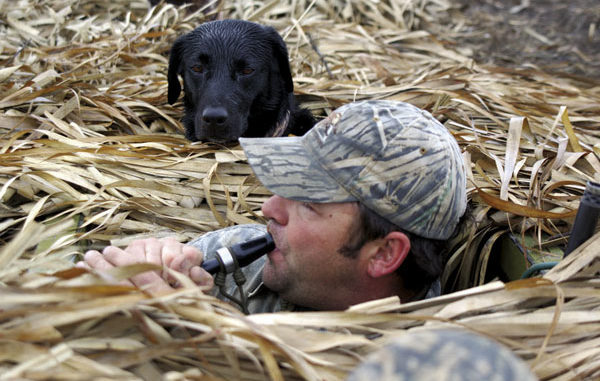
Follow these tips to get both ducks and geese coasting into your ag fields.
David Sims exchanged yodels with wary specklebellies, coaxing them ever closer to our pit blind. Stopping to catch his breath before starting another series of calls, he whispered to remind us, “Wait ’til I say shoot ’em.”
The crisp cold temperature, the light overcast and breezy conditions had birds on the move. The expanse of agricultural prairie swelled with the wild sounds of geese calling to one another in the atmosphere above.
And the bunch that Sims peeled away from the direction they were headed now seemed to like what he was telling them.
“Come on, come on, come on — keep coming, keep coming, keep coming,” Sims whispered to himself, to the point as if mental telepathy would will them into gun range.
He had worked these geese hard.
Most everyone in the blind had traveled a long way from home to make the combo duck-and-goose hunt in the southwestern rice fields. Anxious was an understatement for how everyone felt. And why not? It’s not every day hunters get an opportunity to do this type of hunting.
Though expectations were high, we all knew that hunting late in the second split would have birds skittish from pressure that followed them from Canada to the Louisiana coastline.
“There are times you come out here, and you know you’re not going to shoot anything — that’s tough,” Sims said. “The odds are stacked against you. The weather’s not good and you know if it were up to you, you wouldn’t be hunting that day. It might be a bluebird day with no wind and no clouds. I’ve been out during a full moon and 30 minutes before shooting time I’m watching ducks and geese flying all over the decoys. Come shooting time, they’re gone.”
Sims, 34, has been guiding for ducks and geese since his late teens — just helping out at first, and then later trusted to take clients out. Over that course of time, he has developed a sense for what works to ensure hunters take home a few birds.
“Concealment is probably the biggest thing late in the season,” Sims said. “You’ve got to figure that every rice field they fly over, it has got a little horseshoe cut in the rice, there are decoys, flapping decoys everywhere and every time they see one of those, they get shot at.
“The things you could get away with early in the season you can’t the later in the season it gets. You first and foremost have to remain really well hidden.”
The pit blind we were in could comfortably seat several hunters. Prior to legal shooting light, Sims had us take Fast-Grass mats, and place them shoulder to shoulder, where there wasn’t much more than a ball cap-sized hole to peek our heads out of.
Situated between two fields along a levee, the blind looked natural. With one field flooded more than the other, Sims had a mix of duck floaters and full-bodied standing goose decoys on the shallower field and all floaters on the other, which according to Sims should be maintained at no more than 10 inches in depth. Full-bodied decoys were also placed on top of the levee nearly touching our blind.
“When doing a combo duck-and-goose hunt, you have to have a field set up where you can have a good amount of both decoys,” Sims said. “It needs to look good, and it needs to look realistic to the birds.
“Typically, what we do is have all of our duck decoys in the flooded field with full-bodied goose decoys mixed in but more to the outside of the spread. As we get toward the levee, we’ll get our full-bodied goose decoys on top and place more goose decoys behind the blind and out into the dry field — if it happens to be dry.”
Sims pointed out a lot depends on wind as well, saying when he sets up a spread he always tries to make sure he has the right wind, because geese land into it. If the decoys happen to be on the wrong side, hunters should consider themselves fortunate should they happen to get a few shots out of the situation.
Sims, a master duck and speck caller, will ask clients from time to time to help him call ducks if they are not responding to his enticements. Such was the case on the duck-and-goose combo I was doing with him in the rice fields.
“John, can you call?” Sims asked.
In my blind bag were my calls, and I wasn’t about to put them around my neck on this trip, where clients were banking on his skills.
“Uh, yeah, I can call,” I replied.
“I’ll start off and about the third or fourth note, you come in and finish,” Sims instructed.
Lo and behold, during different passes of mixed birds that included pintails, shovelers, greenwing teal and mallards, the tactic worked.
“It was something we simply discovered,” said Sims, who guides for David Smith Hunting south of Jennings. “One day out of the blue, one of us was calling some birds and the other kind of piped up and came in right after the initial call, and the birds responded.
“During the season, especially the later it gets, it gives you another tactic. Sometimes it doesn’t work and will backfire on you, but it adds another dimension to the sound. You also don’t need two really top-notch callers — just a couple of guys who know the basics and can make a few noises.”
Sims mentioned that waterfowl hunters wanting to try the tactic for the first time may struggle with the natural tendency for the second caller to hit note for note what the first caller is doing. The second caller needs to focus on the note he’s to come in on, where it sounds like two different ducks.
“When you’re sounding like a duck and he’s sounding like a duck, it can be a total hunt changer immediately,” Sims said. “And it’s also fun for the client as well. It gets them more involved in the hunt; it’s something they’ll remember forever.”
Sims cautions that quite often in the late season, ducks and geese sometimes respond to no calling. Moreover, it can be just the opposite the very next day, where the guide calls and fights them all the way into the decoys until their feet touch the water.
During the late season, Sims will also tinker with the numbers of decoys he uses.
“A lot of times we’ll change up decoy spreads,” he said. “We may go to very few decoys — something like 10 or 12 dozen. Or we may go to just one dozen and try that for a while. We’ll try using or not using the motion decoys — a lot of times we take them out altogether just because the birds have been seeing them all season. But changing up your spread and doing something different than everybody else is doing can and will make a difference.”
The specks Sims had been working tirelessly for what seemed like eons now maneuvered downwind, positioning for final approach. With full flaps down for landing in our spread, something spooked all but one. With landing gear down, the lone goose was committed toward a group of full-bodied dummies on my end of the blind.
I could see its white face, the black bars on its breast and its big orange feet begin to extend.
Suddenly, Sims called out, “Shoot him!”
And one report came from the gun of my blind mate next to me — the goose was too far on our end for those on the opposite end to fire safely. The big speck landed with a thud and a bounce, just a few feet from the pit blind.
We managed a mixed bag of snow geese, specklebellies and ducks consisting of pintails, bluewing and greenwing teal and a few spoonies.
